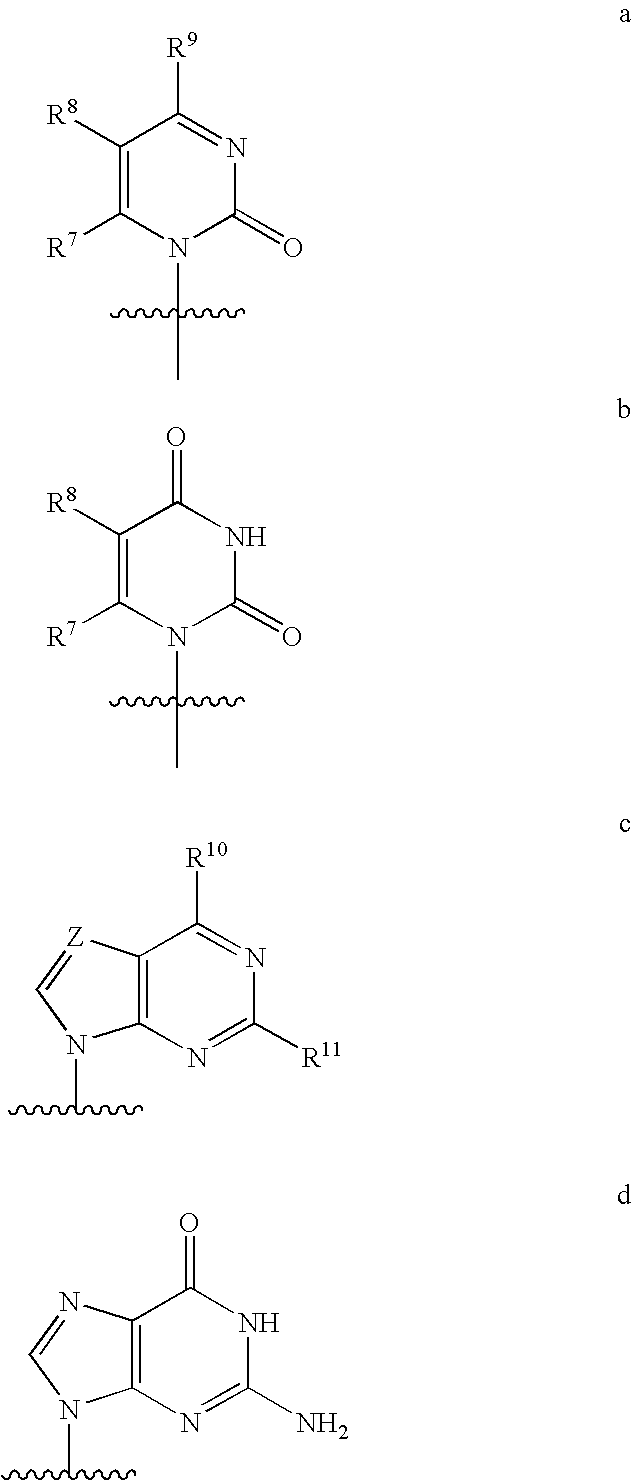Nucleoside phosphoramidate prodrugs
- Summary
- Abstract
- Description
- Claims
- Application Information
AI Technical Summary
Benefits of technology
Problems solved by technology
Method used
Image
Examples
example 1
General Procedure for Preparation of Phosphorodichloridates
[0838]
[0839]A solution of the appropriate phenol R1—OH (1 eq) and triethylamine (1 eq.) in anhydrous ether was added dropwise to a stirred solution of phosphoryl trichloride 1 (1 eq) at 0° C. over a period of 3 hours under nitrogen. Then the temperature was warmed to room temperature, and the reaction was stirred overnight. The triethylamine salt was quickly removed with suction filtration and the filtrate concentrated in vacuo to dryness to afford 2 as an oil which was used without further purification.
example 2
General Procedure for Preparation of Phosphorochloridates
[0840]
[0841]A solution of triethylamine (2 eq) in anhydrous dichloromethane was added dropwise to a solution of aryloxy-phosphodichloridate 2 (1 eq) and the appropriate amino ester 3 (1 eq) in anhydrous dichloromethane with vigorous stirring at −78 ° C. over a period of 30 to 120 minutes. Then the reaction temperature was allowed to warm to room temperature and stirred over night. Solvent was removed. The residue was washed with ethyl ether and filtered, the filtrate was dried over reduced pressure to give 4.
example 3
General Procedures for Nucleoside Phosphoramidate Derivatives
[0842]
[0843]A solution of the appropriate phosphorochloridate 4 (6.5 equivalents) in anhydrous tetrahydrofuran (THF) was added to a mixture of nucleoside 5 (1 equivalent) and N-methylimidazole (8 equivalents) in anhydrous THF with vigorous stirring at room temperature and the reaction mixture was stirred overnight. The solvent was removed in vacuo and the crude was purified by column chromatography and / or preparative thin layer chromatography to give I.
PUM
| Property | Measurement | Unit |
|---|---|---|
| Electric charge | aaaaa | aaaaa |
| Electrical conductance | aaaaa | aaaaa |
| Electrical conductance | aaaaa | aaaaa |
Abstract
Description
Claims
Application Information
 Login to View More
Login to View More - R&D
- Intellectual Property
- Life Sciences
- Materials
- Tech Scout
- Unparalleled Data Quality
- Higher Quality Content
- 60% Fewer Hallucinations
Browse by: Latest US Patents, China's latest patents, Technical Efficacy Thesaurus, Application Domain, Technology Topic, Popular Technical Reports.
© 2025 PatSnap. All rights reserved.Legal|Privacy policy|Modern Slavery Act Transparency Statement|Sitemap|About US| Contact US: help@patsnap.com



